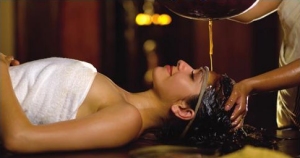 Ayurveda emphasizes preventative and healing therapies along with various methods of purification and rejuvenation. Ayurveda is more than a mere healing system, it is a science and art of appropriate living which helps to achieve longevity. It can also guide every individual in the prevention of disease and long term maintenance of health. To achieve this balanced state of body, mind and consciousness, Ayurveda prescribes Panchakarma Therapy for the cleansing of body toxins. Ayurveda emphasizes preventative and healing therapies along with various methods of purification and rejuvenation. Ayurveda is more than a mere healing system, it is a science and art of appropriate living which helps to achieve longevity. It can also guide every individual in the prevention of disease and long term maintenance of health. To achieve this balanced state of body, mind and consciousness, Ayurveda prescribes Panchakarma Therapy for the cleansing of body toxins.
What is Panchakarma
As the name suggests, Pancha in Sanskrit stands for Five and Karma are the therapeutic measures, therefore Panchakarma means five types of therapeutic measures. These are undertaken for the purification of the body and Ayurveda considers it necessary before the start of any other therapy. The logic being that as a cloth needs to be purified or cleaned of impurities and dust before it can be permeated with a new color, similarly the body needs to be purified before it can be permeated with new colors of youthfulness, health and vigor etc. In fact, most of the time, Panchakarma is an end in itself rather than a prelude to other therapeutic measures.
The Panchakarma therapy of Ayurveda is comprised of five basic types of advanced treatment for the evacuation of vitiated Dosha (toxic materials) from the body. One can consider this as a body de-tox program. There are so many subtypes of this therapy and different types of herbal massages, fomentation's such as steam, external oil treatments, Basti (medicated enemas), Virechana (purgation through herbs), Vamana (emesis through herbs), Nasya (nasal administration of oils) etc. are also incorporated. These practices are extremely helpful in relieving deep seated diseases as well as being beneficial for maintaining and improving physical and mental health.
Purvakarma: Pre-purification Measures for Panchakarma
Before the actual operation of purification begins, there is a need to prepare the body in prescribed methods to encourage the release of toxins. The two procedures are Snehana and Swedana.
Snehana (Abhyangam) is the oil massage. Oil is applied to the entire body with a particular type of massage which helps the toxins to move towards the gastro-intestinal tract. Oil massage also makes the superficial and deep tissues soft and supple, thus helping to remove stress and to nourish the nervous system. Snehana is given daily for three to seven days, as indicated.
Swedana is sudation or sweating and is given every day immediately following the Snehana. An herbal concoction may be added to the steam to further loosen the toxins from the individual. Swedana liquefies the toxins and increases the movement of toxins into the gastro-intestinal tract.
Pradhanakarma: Main Purification measures of Panchakarma
Vamana: Emesis Therapy
When there is congestion in the lungs causing repeated attacks of bronchitis, colds, cough or asthma, the Ayurvedic treatment is therapeutic
vomiting - Vamana, to eliminate the Kapha whic is causing the excess mucus.
Virechana: Purgation Therapy
When excess bile, Pitta, is secreted and accumulated in the gall bladder, liver and small intestine, it tends to result in rashes, skin inflammation, acne, chronic attacks of fever, vomiting, nausea and jaundice. Ayurvedic literature suggests in these conditions the administration of therapeutic purgation or a therapeutic laxative.
Nasya: Nasal Administration
The nose is the doorway to the brain and it is also the doorway to consciousness. The nasal administration of medication is called Nasya. An excess of bodily humors accumulated in the sinus, throat, nose or head areas is eliminated by means of the nearest possible opening, the nose.
Basti: Enema Therapy
Vata's predominant site is the colon. Ayurvedic Basti involves the introduction into the rectum of herbal concoctions of sesame oil, and certain herbal preparations in a liquid medium. Basti, is the most effective treatment of Vata disorders, although many enemas over a prescribed period of time are usually required. It relieves constipation, distention, chronic fever, cold, sexual disorders, kidney stones, heart pain, backache, sciatica and other pains in the joints. Many other Vata disorders such as arthritis, rheumatism, gout, muscle spasms and headaches may also be treated with Basti. Basti therapy is divided in two main types - Anuvasana Basti - medicated oil enemas and Niruha Basti - medicated enema of decoctions and medicated oils.
Other miscellaneous therapies of Panchakarma:
Shirodhara: It is recommended in anxiety, depression, hypertension, insomnia etc.
Kati Basti: Useful in different backaches.
Janu Basti: Useful in arthritis of the knee joint.
Nadi Sweda: Useful in pain disorders of different sites.
Pinda Sweda: Useful in neurological ailments and in the management of different pains.
Shashti-Shali Pindasweda: Useful in neurological ailments.
Tarpanam: Useful in the ailments of the eyes.
Shirobasti: Useful in hair loss and the falling hair and other diseases of skull.
Uttara Basti: Useful in genitourinary diseases and infertility of female.
Udvartana: It is a medicated Ubtan to be applied over the skin for fair and glowing skin.
|
|